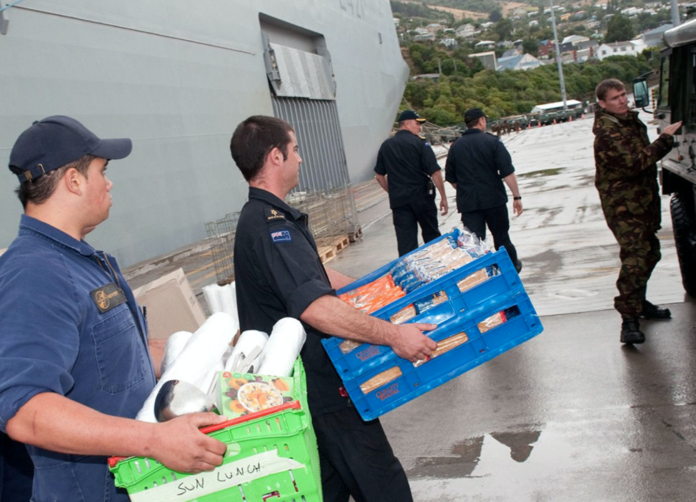Ten years ago New Zealand Defence Force (NZDF) personnel were in the South Island gearing up for the NZDF’s bi-annual exercise, Southern Katipo. Troops were ready, air assets were on the tarmac and HMNZS Canterbury was berthed at Lyttelton Port making final preparations before the exercise got underway.
Then, at 12:51pm, a 6.3-magnitude earthquake struck the city of Christchurch. The earthquake killed 185 people and injured thousands and caused severe damage in Christchurch and Lyttelton. The NZDF responded by undertaking its largest-ever humanitarian assistance mission.
Commanding Officer of HMNZS Canterbury at the time, Rear Admiral (RADM) Jim Gilmour remembers it vividly.
The ship was alongside Lyttelton completing the loading of Light Armoured Vehicles (LAV) and personnel who would be deployed during Exercise Southern Katipo 11.
“When the earthquake struck I was on the bridge, alone, observing the last of the LAV’s being loaded by crane – it was going slowly and I was anxious for the ship to get going.
“At 12:51pm the ship began to shake violently. Air-conditioning vents on the bridge fell to the deck and a loud rumbling sound went through the ship. I initially thought there was a serious problem in the engine room or with the cranes which might have been causing the shaking,” he said.
RADM Gilmour noticed dust rising from Lyttelton.
“I saw a church steeple topple and the shop front façade near the port entrance collapse onto the road and parked cars. A large boulder came down the slope from the ridge behind the town and it disappeared into the upper neighbourhood. The wharf we were berthed decoupled from the land.”
Thinking about the possible tsunami threat, RADM Gilmour decided the ship should leave port as soon as it could “in order to preserve the capability to support the response that would surely be needed”.
He made the order to bring the ship to immediate notice to sail, and to be ready in just eight minutes, a process that usually takes an hour. As the ship was about to let its lines go, RADM Gilmour noticed heavy discolouration in the harbour basin and realised that the depth of water could no longer by trusted.
“We tripled up our lines, dropped both anchors and proceeded to discharge the vehicle cargo which predictably would be needed as emergency services gained an understanding of what would be required,” he said.
HMNZS Canterbury’s company provided immediate support to Lyttelton after the earthquake.
“We provided meals to the community, security for businesses including the bank which was open all the way to the vault, we were a command and control hub, and supported our divers and hydrographers in opening the port.”
Once the port opened, HMNZS Canterbury shifted essential cargo from Wellington to Lyttelton returning to Christchurch with consignments of supplies, including portable showers, excavators, trucks and trailers. In total the ship transported nearly two thousand tonnes of vehicles and equipment, and 375 personnel in and out of Lyttelton.
HMNZS Pukaki, Otago and Resolution also supported the mission, delivering people and freight in and out of Lyttelton, and surveying the harbour.
RADM Gilmour said that besides the event itself, he was particularly moved by the national remembrance service which occurred a week to the minute of the earthquake.
Nine days earlier he had been with the ship in Napier commemorating the role of HMS Veronica in response and recovery following the devastating earthquake in 1931.
“When HMS Veronica was later decommissioned, the ship’s bell was gifted to the City of Napier and is rung each year in commemoration of the event. The ceremony was very moving – a mix of pride and grief,” he said
He said that just nine days later ringing HMNZS Canterbury’s bell with his Defence Force colleagues at the Lyttelton fire station service was surreal.
“No local church was safe to host the ceremony and all of the steeples had collapsed so our bell, from the ship bearing the regions name, was carried and mounted to ring out for the 185 New Zealanders who had fallen,” he said.
“I am still struck by the dedication and professionalism of my ship’s company and all of those members of the New Zealand Defence Force that ran towards the disaster to play our role in the response.
“I am equally impressed by the resilience of the people of the Canterbury region who fought through this disaster,” said RADM Gilmour.
1,796 Defence Force personnel made up of 239 Navy, 1,379 Army and 150 Air Force regular and reserve personnel were directly involved on the ground in Christchurch in 2011. Behind these people were many more working in support from camps and bases around the country. The support ranged from medical, logistical, and planning, to engineering tasks, cordon maintenance, and forensic dentistry.



